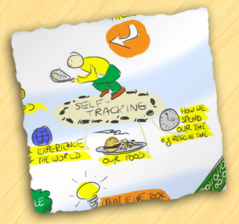- Home
- Blogs
- Rob Cottingham's blog
- Use sketchnotes and graphic recording to spread your speech's message
Use sketchnotes and graphic recording to spread your speech's message
- 22 March, 2013
- 1 comments

A social speech has the power to extend your message's reach beyond the audience in attendance. And one of the most powerful ways you can do that is by encapsulating that message in a self-contained, easily-shared piece of content: a social object.
Think of it as a spur to conversation: something that people will share and talk about online. (Jyri Engeström first coined the term, but cartoonist Hugh Macleod has done a lot to put it into practical terms.) For your speech, that social object could take many forms: A great clip of the key moment from your speech. An infographic illustrating and supporting your argument. A striking and relevant image, captioned with a text quotation from your speech.
Or it could take the form of graphic recording: an increasingly popular way of capturing the essence of speeches and conversations as illustrations, usually drawn live and in the moment.
Innovative workshop facilitators have been using graphic recording now for years. (Here's Nancy White doing her marvellous graphic take on my Northern Voice talk from 2009.) And now it's hitting the mainstream with everything from RSA's now-famous whiteboard animations to sketchnotes at events like SXSW and (cough) the Nonprofit Technology Conference.
The folks at Duarte Design created a series of illustrations from last month's TED 2013 talks – garnering more than 100,000 views on Slideshare. Here's how one of them, capturing seven different talks, came together:
You don't have to be nearly as ambitious in scope and scale, of course. But even a few simple sketches along with explanatory text can help your message spread – and inspire conversations that can lead to connection, action and impact.
And those sketches don't require any special artistic training or cartooning skill. Books like The Sketchnote Handbook and The Back of the Napkin set out simple techniques you (or someone in your organization) can use to illustrate a message with clarity and power, even if you haven't dared to doodle since grade school. And the Sketchnote Army website offers inspiration on demand, with tons of examples to learn from.
Add some identifying information — the speaker's name, the event and date, an URL and a Twitter ID — and you're ready to release your sketchnote into the wild as a social object. There are countless ways to do it:
- post the image to your blog
- post the image to Flickr
- tweet it out after the speech
- add it to the slide deck you post on Slideshare
- turn it into a Prezi
- animate it a little and post it to YouTube
Whichever way you share it (and any other social object you create), follow and join the conversations it triggers, and engage with the networks it helps you build.
P.S. – I'm convinced the current popularity of hand-drawn live notes owes no small debt to the impact of Common Craft's fantastic explanatory videos. So it's no accident that I'll also heartily recommend Lee LeFever's The Art of Explanation, which is great on images and can help you add sound and video to the mix.

Work Smarter with Evernote

Get more out of Evernote with Alexandra Samuel's great new ebook, the first in the Harvard Business Press Work Smarter with Social Media series!



Comments
Nancy White says